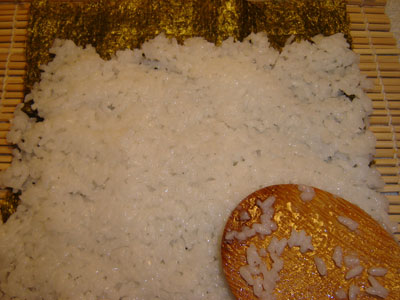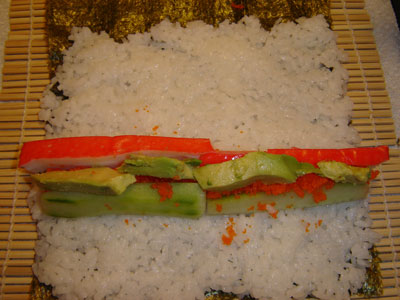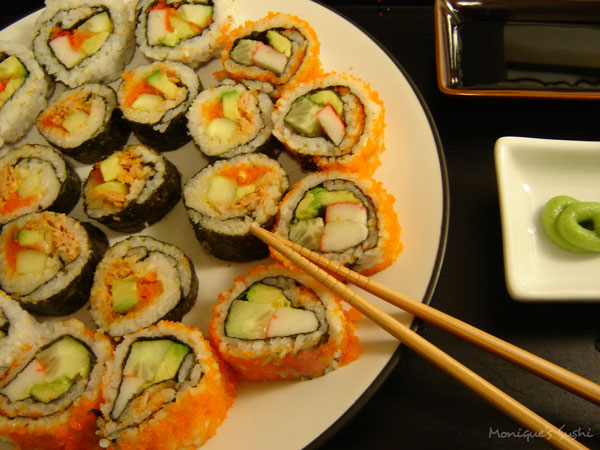I love East Asian food. I love it so much that it’s possible that was probably Asian in a past life. I made some sushi the other night, and let me tell you that for a Black girl I make it pretty damn well. ;) A hit at all my dinner parties that I throw at home, it’s a shame that it took me so long to realize that sushi (at least the basic type) can be super-easy to make myself. If you’re craving some Japanese cuisine, there’s no reason to go out to the semi-expensive sushi bar, because you can create your own filling rolls right in the comfort of your own home–for a fraction of the price. Sure it may be a bit tricky at first, but once you get the hang of it, you’ll be tempted to start your own all-you-can-eat sushi restaurant (okay, perhaps that’s a little far fetched, but you get the point).
Now there’s a myriad of types of sushi, but this is a recipe for basic, cheap & simple Monique-Rolls ;) aka California rolls and Tuna rolls. For a short course on some of the terms and a background on Japanese sushi visit the Wikipedia article on sushi.
Here’s a list of things that you’ll need before you begin:
- A Bamboo Rolling Mat
Also known as a makisu. Can be found at virtually all Asian grocery stores and at some regular grocery chains - A Rice Paddle
Also known as a shamoji. I purchased a bamboo one at an Asian grocery store for about $1.30… you can try your local dollar store - A Large Bowl
Preferably glass or heavy plastic… stay away from metal - A Cutting Board
Ingredients:
(all the prices posted are based on my purchases from the local Asian grocery supermarket)
- Nori
This is the seaweed wrappers used in maki. I usually use Marufuji Yaki-Sushi Nori because of it’s high quality. Just make sure the nori sheets you buy is thick, smooth, and doesn’t have any holes. (approx $2.50 for a pack of 10 sheets) - Sushi Rice or Calrose Rice
The key part of any sushi meal. To make 4 sushi rolls (which could then be cut into about 30 individual pieces), I use 2 cups of rice. When cooking, a 1:1 ratio should be used in order for your medium-grain rice to come out well.
(about $3 for a 2kg package) - Imitation Crab or Canned Tuna
- Fresh Vegetables (cucumber, carrots, avacado)
- Fish Roe
There are several types of fish roe you can use for maki filling/coating, such as masago, ikura, kazunoko and tobiko. I use masago. ($3 for a small container) - Rice Vinegar
Very important when making sushi. I always purchase Marukan’s Seasoned Rice Vinegar. They also sell the unseasoned kind (which you’d have to add a bit of salt and sugar to for sushi). Seasoned rice vinegar can also be used as a marinade for meat, fish and veggies. I use about a couple tablespoons for each cup of rice. ($3) - Soy Sauce
There are several types available. I’m quite fond of Kikkoman’s Sushi & Shashimi Soy Sauce because it’s a bit sweeter and milder than the original. ($2-3) - Wasabi (optional)
A piquant paste made from the grated root of the wasabi plant. According to Wikipedia, it has anti-microbial properties and may reduce the risk of food poisoning. I mix a bit of S&B’s brand of wasabi in with my soy sauce for dipping. ($2.50/tube) - Gari (optional)
Sweet, picked ginger eaten to cleanse the palate and help with digestion. (I never purchased this before, but the bottle is about $4-5)
Instructions:
- Wash The Rice
This is very important. Make sure you wash it several times until the water runs fairly clear after while you drain it. - Cook The Rice
I use a rice cooker, because it does the job so well. But if you don’t have one, a decent pot with a lid will do. Cook the rice for about 15-20 minutes on low heat with the lid covered. - Prepare Your Fillings
Now that you have some free time, you can prepare your fillings for your maki rolls. Cut an English cucumber in half lengthwise, then down the middle again so that you get the strips small enough to fit within the maki rolls. Sometimes it can be chopped finer. If you want to add some carrots to your California Rolls, go right ahead. In the past I’ve used baby carrots because they’re easier to slice finely. To prevent your avocado from turning brown (due to oxidation), after peeling and slicing wrap them tightly in plastic wrap. You can also spritz some lemon juice on them to keep them fresh. Peeling and cutting an avacado can be tricky… the avocado peeler is your friend. Masago freezes well, so I usually buy a bulk pack for about $5 and then defrost some in the fridge when I need to make sushi rolls.I use imitation crab for my sushi rolls, specifically crab-flavoured Alaskan Pollock. I cut my crab-sticks in 1/2 so that there’s more room for other filling within the roll. For my tuna rolls, I use Clover Leaf’s Spicy Thai Chili Tuna, but you can just use plain, flaked tuna and mix it with a bit of mayo and hot sauce.
- Prepare Your Rice
After the rice has finished cooking, pour it into a mixing bowl and add some rice vinegar (for each cup of rice, I use about 2 tablespoons of vinegar). Mix the rice vinegar with the rice using the rice paddle in careful, chopping motions… being careful not to ‘smoosh’ the rice. Let your rice cool to room temperature (fanning it will help speed up time). -
Layout Your “Rolling” Area
I place a large cutting board on my counter top, place my fillings around it for easy access, then put my rolling mat in the centre. Sometimes people cover their rolling mat with plastic wrap or a large Ziplock bag for easy clean up, especially when making uramaki (inside-out rolls).
- Fill That Nori
Place a sheet of nori (rough side up) on the bamboo mat. Depending on weather you like your rolls thick or thin, you can cut the sheet of nori in half lengthwise. I like ’em thick, so I use the whole sheet. Using your paddle, spoon some rice onto the sheet of nori, coating it to the ends. This is where your bowl of water comes in handy. I dip my wooden paddle in the water to moisten it a bit, so that the rice doesn’t stick to it as much and easily comes off onto the nori.Note that if you’re making regular makizushi (nori on the outside), leave about a 1/2 inch of the nori on top uncovered, so that it’s easier to seal. For uramaki (rice on the outside), spread the rice to the ends, putting a thicker layer of rice near the top to make sure none of the nori pokes out after you roll. Place your ingredients about 3/4 of the way down from the end of the nori sheet. If you put it right at the end it will be difficult to roll it up. I usually stack my cucumbers and crab first, then layer the avacado and masago on top. For Uramaki, you’ll have to flip the rice-covered nori over THEN place your ingredients on the nori side of the sheet before you roll (you can sprinkle toasted seseme seeds on the rice before you flip, or wait until after you roll it up).

- Roll ‘Em, Baby

Very carefully, begin rolling your roll (lol, that sounds funny) from the side closest to your body. Make sure you don’t roll up the plastic wrap or bamboo sheet into the roll you’re making. Basically, you’re going to roll a bit (picking up the bottom of the nori and covering the part of the roll with the filling), and apply some pressure with the bamboo mat to keep things tightly intact. After you roll uramaki, you can roll it on some masago or toasted seseme seeds (so it sticks to the rice) for some extra flavour and presentation. For regular maki, make sure you wet the top edge of the exposed nori a bit, to seal in the edge of the roll. - Cut It
Using a sharp, wet knife, slice your sushi roll into about 6-8 pieces. I find that using a serrated knife helps with the cutting process (especially the nori), but as long as it’s a good, sharp knife it should cut the maki roll nicely. - Present It
Sushi’s really all about presentation. I purchased some really nice sushi plates and condiment
 bowls from Winners (at a good price). I’m pretty sure you can find them at your local department store or Asian supermarket. Pour some soy sauce into a small bowl and add a bit of wasabi and gari if you like. Don’t forget the chopsticks.
bowls from Winners (at a good price). I’m pretty sure you can find them at your local department store or Asian supermarket. Pour some soy sauce into a small bowl and add a bit of wasabi and gari if you like. Don’t forget the chopsticks. - Eat It
No explanation necessary. Enjoy!
Don’t worry if your sushi comes doesn’t come out right after the first few tries. It may take some practice to get it right. Try some different variations where fillings are concerned. If you’d like more info on how to make your own sushi, along with some advanced instructions, check out these helpful links:
DAS NOT COOL!!!! U CANT POST PICTURES OF WHAT YOU MAKE AND NOT OFFER TO SEND IT OUT TO NE ONE!!! I DONT LIKE YOU!!!!!!!!!!!!!!!!!!!!!!!!!!!!!!!
I’m sorry… next time I’ll FedEx you some. :D
Wow that looks amazing !! I’m getting ready to make sushi for the first time and I can’t wait. Delicious. the reason is I spend too much $$ on my sushi addiction so I figure if I make my own it will be cheaper and fun too . Thanks
I have 3 questions. After attempting the recipe, why does my house and the sushi smell so unbearably fishy..more so than any sushi I have ever eaten?
Is it two tablespoons of seasoned vinegar per cup of cooked rice?
Should I wet the knofe before attempting to cut the sushi?
Many thanks..
this is greatttt :)
im just getting ready to make sushi :)
wow ur a lifesaver have 2 make sushi 4 schoolT_T eseyest one 2 fallow THANK YOU
neat! very good i love your sushi, but i never made some anyways it looks good
thats good maybe i will ttry it some day
Thank you sooo much for posting this extremely helpful step-x-step sushi making guide!! My man has recently tried sushi and loves it, so I thought I would surprise him and make some tonight. I have made sushi in the past, but that was years ago and I couldn’t remember when to put rice wine in the rice. You have rescued my surprise sushi night from disaster! Thank you, and I love your blog btw. :)
Awww… thanks for your comment, Ellen! I’m so glad that my sushi post helped you out! It’s great to experiment with the fillings as well. One of my favourites lately have been the Philadelphia Roll (filled with strips of Philadelphia cream cheese, masago, cucumber and carrot). I’ll try to keep the posts comin’! :)
[…] information on making sushi, MakeMySushi.com had several very helpful guides, and this post from ALotAboutNothing was also very useful in my own […]
This was great help. The key advice is mostly there. I made 8 uncut rolls following this and they turned out amazing.
I used a wet knife to cut the rolls and wet hands to handle the rice ball.